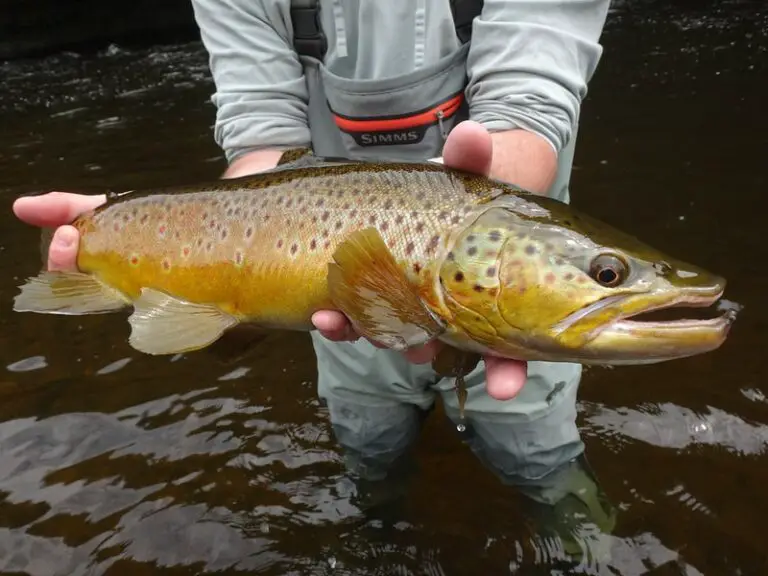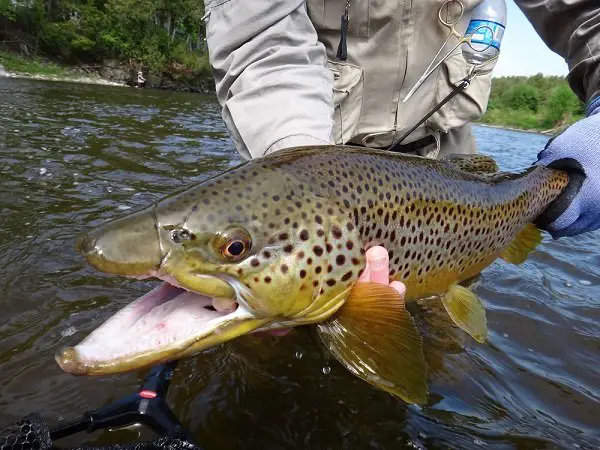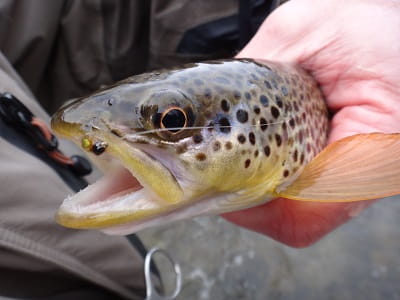What Weight Fly Rod For Trout: What Do Guides Recommend
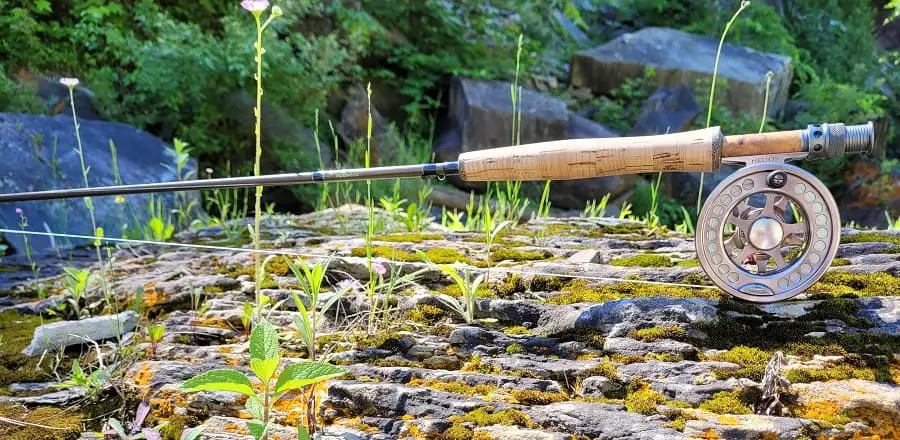
As a river guide, I have multiple fly rods of different weights for different types of trout fishing. The rod I use at any given time usually depends on several factors.
An all-around good-weight fly rod for trout is a five-weight rod. This is what most big stores will sell you. However, the right weight fly rod for trout will really depend on the size of the trout you are fishing for, the size of the water body you fish, the method you want to use, and the size of the flies.
This means an angler who wants to cast large streamers will require a different-weight fly rod than an angler who needs a delicate presentation with small dry flies.
In case you are confused, the weight of a fly rod is a rating system, not how much the fly rod actually weighs. I’ll discuss this more below.
Let’s find out what weight fly rod for trout is best.
| Fly Rod Weight | Ideal Use Cases | Notes |
|---|---|---|
| 0-2 | Small streams, small trout, panfish | Challenging, sensitive, ideal for experienced anglers. Makes small trout feel significant. |
| 3 | Small creeks, small trout, dry fly fishing | Not for large rivers/windy areas. Best for dry fly fishing 8 foot to 9 foot is best. |
| 4 | Small to mid-sized rivers, various flies | Versatile for nymphs, small streamers. Good for small and large trout. Ideal rod length 8’6″ to 9′. |
| 5 | Most trout sizes and situations | Commonly recommended for beginners. Balanced but not optimal for very small/large trout.Good all purpose rod weight |
| 6 | Larger rivers, bigger trout, wet fly fishing, streamers, nymphing with indicators | Better control with bigger flies, good in windy conditions. Suitable for small steelhead, and pink salmon. Not ideal for very small trout. |
Why Consider The Weight Fly Rod For Trout
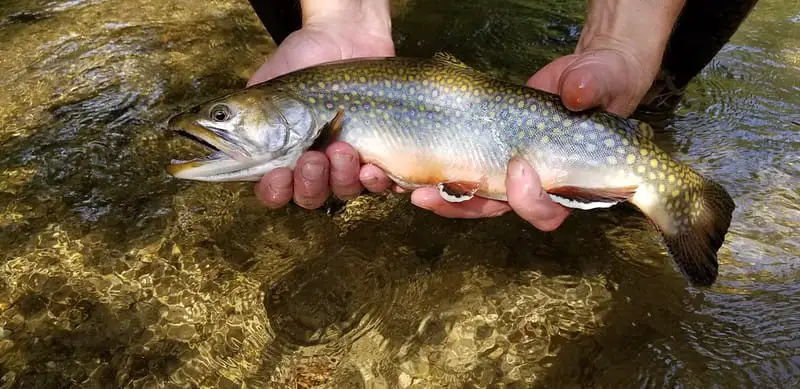
The weight of a trout fly rod is a rating system used only in fly fishing. It allows the angler to match the fly line and reel to the rod. For instance, a 5-weight rod is best used with a 5-weight fly line.
Having your line match the rod will make casting and presentation of the fly easier. You would not want to put a 10-weight fly line on a 3-weight rod. Otherwise, it would not load the rod effectively, and the line would not cast well.
Fly rod weights vary in dimension, from one-weight fly rods, which are used for tiny trout or panfish, to a size fourteen fly rod, which might be used for large fish species like tarpon.
Generally, a higher-weight trout fly rod might start around seven weight and is robust enough and ideal for catching large trout in fast currents or for casting large flies in windy conditions.
On the other hand, a lower-weight fly rod is easier to use on smaller water and smaller trout with smaller flies, but it won’t allow you to pull out a giant trout from big, fast water.
If you are not sure what ly rods are good for trout, check out Best Fly Rods For Trout
What Weight Fly Rod for Trout: All Sizes And What They Are Good For
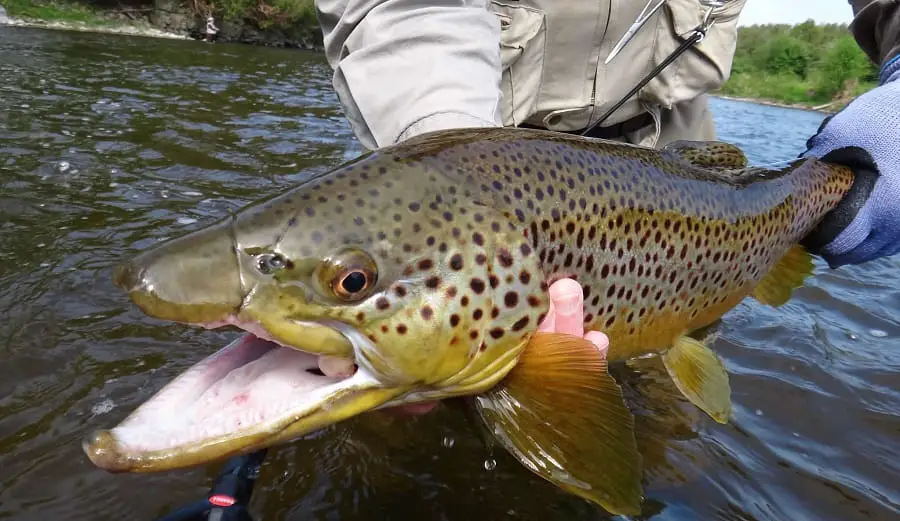
Although the 5-weight rod is a preference of many new anglers, this doesn’t rule out the possibility of using other weight rods based on factors such as fishing conditions, the size of trout you’re targeting, the size of the stream, your fly size, your leader size, and the method you want to fish.
Here are other options for the weight you may wish to consider:
Zero to Two Weight Fly Rods
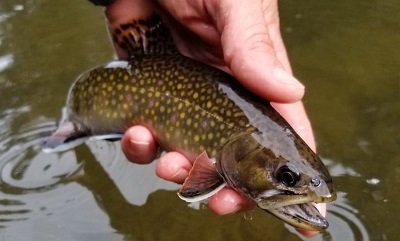
Zero to two-weight fly rods would be considered specialty rods and would normally be used by very experienced anglers for a single purpose.
An angler who wants to fish small streams for small brook trout or panfish and who wants to challenge themselves and have the best feel when fighting these smaller fish.
On this size rod, even a small 6 to 8-inch trout will feel like a bigger fish and provide a better fight and more challenge.
Casting small streams with small dry flies would be fun on this rod. I do not recommend this rod for the average angler.
3-Weight Trout Fly Rod
A 3-weight rod is ideal for fishing on small creeks for small trout and small flies. A 3 weight fly rod for trout offers greater accuracy and control on smaller streams.
This is also a great size rod for anglers that like to primarily dry fly fish and rarely fish rivers that are wider than 40 feet.
A perfect length for the 3-weight rod is about 8 feet to 8’6.
A 3 weight rod is not a good rod for casting and fishing streamers, or when fishing large rivers or high wind areas. You may also struggle to get any distance when fishing larger rivers, ponds, or lakes with a 3-weight rod.
Euro Nymphing: There is a recent trend of anglers fishing with a method known as Euro Nymphing, and many advanced anglers, myself included, will use a 10 or 11-foot 3-weight fly rod for this purpose.
Keep in mind that this is a specialty method and that these longer 3-weight rods feel and fish more like a 4 or 5-weight rod due to the longer length.
For more on this method and the best rod sizes, check out my page Euro Nymphing.
4-Weight Trout Fly Rod
A four-weight fly rod for trout is my preferred fly rod weight for trout on small to mid-sized rivers.
If you are fishing in a small rivers using various flies like nymphs, dry flies, wet flies, and even small streamers, the 4-weight rod is the best match.
Unlike the 3-weight version, the 4-weight fly rod gives the angler just a little more backbone for bigger trout up to 26 inches but is still light enough that small trout will still give you a good fight on the rod.
I prefer my 4-weight rod in the 8’6” to 9-foot length for most situations. A shorter length of 7 feet to 8 feet is good for the bigger trout in the bushy tight cover areas.
5-Weight Fly Rod For Trout
The most commonly recommended trout fly rod is the 9 foot 5 weight rod. The 9 foot 5 weight rod is what many would consider a good all-around fly rod for most situations and most trout sizes. The 5-weight fly rod sits between a rod that is too heavy and a rod that is too light.
Although it could be the best all-around fly rod size for trout, it isn’t always the best rod size, and I will discuss why below.
Although a 5-weight rod could be used to fish a small stream for 5- to 10-inch brook trout, many would consider it too heavy. It would overpower the fish, diminishing their fight.
On the other hand, hooking into a 10-pound rainbow trout and landing it is possible, but your five-weight rod might be too light and make landing the fish difficult. Your 5-weight fly rod might also be too light if you want to cast big streamer flies long distances.
6-Weight Trout Fly Rod
A 6-weight fly rod for trout would be best for anglers who want to fish larger rivers for larger trout or for someone who mostly wants to do streamer fishing.
A 6-weight fly rod will offer greater control with bigger flies and will allow you to get more distance with these larger flies. You will be able to also roll cast better with this heavier rod, and casting in windy conditions is a lot easier due to the heavier rod and heavier line.
You will also be able to control and catch the bigger trout. I have used six weight fly rods for Great Lakes steelhead. Although it is on the light side for these very large fish, it can be used for them.
Fly Rod Weight For Trout In Rivers?
Zero to three-weight fly rods are meant for experienced anglers on tiny trout streams. They also work well when fishing on a river with tight cover or when delicate presentations are required. They are ideal for very small trout like brook trout.
3 to 4 weight fly rod weights are suitable for trout fishing in small to mid-sized rivers up to 50 feet wide. This size rod still makes small trout feel big. In addition, if there’s a heavy shrub or tree cover around the river, then these are the perfect rod size for your trout fishing.
Five and six-weight fly rods are the standard weights for trout fishing on larger rivers, with larger flies, and when streamer and nymph fishing. The upside is that they work on both small and large rivers.
Fly Rod Weight For Trout When Dry Fly Fishing?
In dry fly-fishing, you use artificial flies that float above the water surface, and most of the time, they are very small and lightweight.
As a result, you require a rod that is also light in order to use a light line, which will enable you to make a nice delicate presentation. This means landing the line on the water softly so you don’t spook the fish you are trying to catch.
For this reason, many guides and experienced anglers will use three and four-weight fly rods for dry fly fishing for trout on small to mid-sized rivers.
If you are using dry fly tactics on larger rivers or still waters where distance casting is required, then a 5-weight or 6-weight fly rod might be better simply because you can cast the heavier fly lines farther, especially in the wind.
What Weight Fly Rod When Streamer Fishing?
Streamer fishing typically targets big trout on bigger rivers and is a great method for trout that are often holding deep or near log jams.
Bigger trout in these types of water are essentially not easy to catch using methods like dry fly fishing. When you cast heavy flies for big trout, a good five or 6-weight fly rod that is 9 feet long is best.
For years, I fished 3 to 5-inch weighted streamer flies with my 4-weight. I simply learned to adjust my cast and load the rod properly. With that rod, I landed plenty of trout in the 4 to 6-pound range.
What Weight Fly Rod For Nymphing
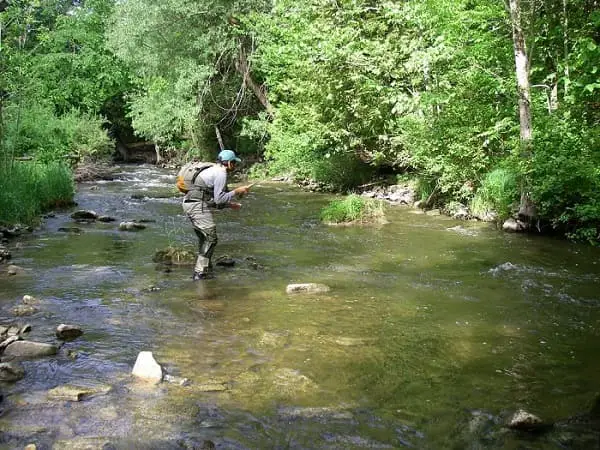
Nymphing can be done using indicators or with no indicators, and when nymphing the casting is very different.
When nymphing, you are also often mending, especially when indicator nymphing. To cast, mend, and fish with an indicator well, a heaver line and heaver rod are required.
I indicator nymph fished with a nine-foot four-weight rod for over 20 years, but many anglers will find that a five-weight or six-weight will be easier. Click the link to see where I discuss best rods and how to indicator nymph well.
What Weight Fly Rod for New Anglers?
Most beginners do not have the fly-fishing experience on their first day of fishing. Thus, when fishing for the first time, you should have a versatile rod suitable for the water type where you’ll be fishing.
As mentioned before, most fishing stores recommend the 9’ 5 rods for first-time anglers because of their versatility. Despite having little experience, it allows adjustments that match the fishing conditions. Thus, it helps you maintain the required accuracy to catch your trout.
Despite this, fishing conditions may vary; hence, selecting a trout fly rod that matches the type of fishing you want to do and the conditions is advisable.
Fly Rod Weights For Trout When Fishing Ponds
Unlike in rivers where water currents may be strong, pond fishing is relatively calm as you’ll be fishing for trout in still water. Therefore, you may not require a high-weight rod unless you’re targeting some giant trout in the pond or need to cast very far.
Rod weights ranging from 5 weights to 6 weights are primarily used for trout pond fishing, with a five weight rod likely being the best option.
A 6-weight fly rod will allow you to make longer casts with both a traditional cast and a roll cast, and you can use most flies, including streamers, with this size rod.
However, this doesn’t mean you can’t use smaller fly rods, especially if you plan to only dry fly fish. If you mostly dry fly fish, a 4-weight rod would be a better choice. However, your casting distance might suffer a little compared to a heavier rod.
What Size Fly Rod For Trout When Fishing Lakes
Fly fishing in the lake requires a fast-action rod that is strong enough to cast into the wind. In addition, you may also need a weighted fly line, and therefore, you will need a rod that can handle that extra weight.
Most anglers use a six or 7-weight fly rod when fishing for trout in a lake.
A high-weight rod comes in handy if targeting some big trout in the lake. Thus, you’ll use heavier flies that give you a powerful grip for your catch.
Most Important Considerations
When choosing the right weight for a fly rod, some critical considerations come into play. These include the size of the trout, the size of your flies, and prevailing conditions such as wind.
1. The Size of the Trout
When fly-fishing, you should be clear on the size of trout you’ll be targeting. If you are lucky to be living near a river or lake with large trout, a two-weight rod just won’t cut it, and you will require a heavier rod of around six weight. On the other hand, smaller species need a smaller rod size, such as 3 to 5-weight.
2. The Size of the Flies
The size of the fly you are throwing is also an important consideration you shouldn’t overlook.
For instance, a 5-weight or 6-weight rod can effectively support a big and bulky fly and smaller flies or when using bulky tungsten nymphs or streamers.
Smaller dry flies can be cast best with two to four-weight rods.
3. Prevailing Winds
A lighter rod may not withstand the effects of strong winds during fly-fishing, and you will struggle to cast and get any distance. If you fish mostly open and windy areas, consider investing in a minimum 5-weight rod.
4. Type of Fly Fishing
Trout fly-fishing involves many methods, such as the wet fly swing, dry fly fishing, streamer fishing, indicator nymphing, and euro nymphing. This means slinging different flies, and these methods can require different weight fly rod for trout.
Depending on the choice of your fly, you should settle for the excellent trout fly rod. For instance, if you are using dry flies, then a 5-weight fly rod is enough. But if you have heavy streamers, you’d require a 6-weight fly rod.
5. Type of Water
Where do you plan to fish for trout? Is it a small stream where most trout do not exceed 10 inches in length, or will you be streamer fishing a large fast river or in a large lake?
Whatever your choice of fishing grounds, you should consider buying a rod that will allow you to effectively fish the size of a waterbody you fish most.
I also recommend checking out my article series on Fly Fishing For Trout, which was put together by guides to help you out.
If you have a question, comment, or advice, let us know in the comments section below.
Tight Lines,
Graham


